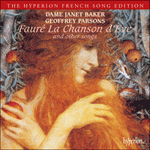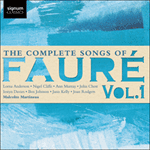
Welcome to Hyperion Records, a British classical label devoted to presenting high-quality recordings of music of all styles and from all periods from the twelfth century to the twenty-first.
Hyperion offers both CDs, and downloads in a number of formats. The site is also available in several languages.
Please use the dropdown buttons to set your preferred options, or use the checkbox to accept the defaults.

Levati, sol che la luna è levata;
Leva degli occhi miei tanto dormire.
Il traditor del sonno m’ha ingannata;
Il meglio [bello] amante m’ha fatto sparire.
Fauré’s ascending phrase at the beginning of the vocal line is a more logical fit for the rising sun of ‘Levati, sol’ than for ‘Dans un sommeil’. Neither Italian nor French version is convincing in terms of prosody, probably as a result of the compromises involved in making a bilingual edition of the song. If Bussine made the French version before Fauré began to compose, and the composer conceived his music for the French text, it is a miracle that the Italian, included in the song’s first edition, also fitted the music. (In preparing the French lyric Bussine seems to have relied more on Tommaseo’s footnote to ‘Levati, sol’ than on the Italian poem itself.) Fauré’s cantilena is a cornucopia of melodic plenty: the music unfolds organically from beginning to end, each phrase leading ineluctably to the next, an endless flowering. This in turn is supported by seemingly inevitable harmonies, but Fauré’s popular touch masks the greatest subtlety. Pau Casals’ instantly famous version of the piece for cello and piano (1910) proved how easily a tune like this can become a song without words.
from notes by Graham Johnson © 2005
Levati, sol che la luna è levata;
Leva degli occhi miei tanto dormire.
Il traditor del sonno m’ha ingannata;
Il meglio [bello] amante m’ha fatto sparire.
La phrase ascendante de Fauré, en début de ligne vocale, convient logiquement mieux au soleil levant de «Levati, sol» qu’à «Dans un sommeil». Ni la version italienne ni la version française ne sont convaincantes en termes de prosodie, ce qui tient aux compromis inhérents à l’élaboration d’une édition bilingue de la mélodie. Si la mouture française de Bussine est vraiment antérieure à la composition de Fauré, si ce dernier a bel et bien conçu sa musique pour le texte français, alors c’est un miracle que l’italien, inclus dans l’édition princeps de la mélodie, convînt lui aussi à cette musique. (Lorsqu’il rédigea les paroles françaises, Bussine semble s’être davantage attaché à la note en bas de page de Tommaseo sur «Levati, sol» qu’au texte italien même). La cantilène fauréenne est une corne d’abondance mélodique: la musique se déploie organiquement de bout en bout, chaque phrase en appelant inéluctablement une autre – une floraison ininterrompue, elle-même soutenue par des harmonies apparemment inévitables; mais la touche populaire de Fauré masque la plus grande des subtilités. Pau Casals fit de cette pièce une version pour violoncelle et piano (1910), qui connut une célébrité immédiate, démontrant la facilité avec laquelle ce genre d’air peut devenir une romance sans paroles.
extrait des notes rédigées par Graham Johnson © 2005
Français: Hypérion
 Elegy ElegyRightly feted recitalists Mary Bevan and Joseph Middleton explore the unique ability of music to give expression to the complexities of grief and loss in a programme of timeless classics and unexpected byways.» More |
 Fauré: La chanson d'Ève & other songs Fauré: La chanson d'Ève & other songs‘This varied and generous selection of 28 songs is perhaps the best general introduction to this important side of Fauré's output and is also one of G ... ‘Deeply considered and deeply moving performances’ (BBC Record Review)» More |
 Fauré: The Complete Songs, Vol. 1 Fauré: The Complete Songs, Vol. 1Malcolm Martineau brings together some of the UK’s finest singers for the first release in a new series charting the complete songs of French composer Gabriel Fauré.» More |

